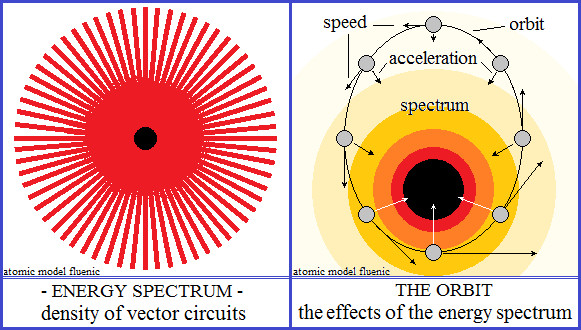Densities of the energy
Dynamics of energy densities spectrum.
The energy densities spectrum is a new interpretation of the structure
of
orthogonal circuits organized by energy with vector properties. One of
the
orthogonal circuits is the electrode, a vector circuit surrounded orthogonally
by its magnetic circuit. The maximum density of the circuits is in the
electrode
and in the center of the magnetic axis, from where it is propagating radially,
so decreasing, to the density of vector space, at light-year distances
(in galaxies).
The structure with the densities of the closed vector circuits, relatively
static,
constitutes spectrum of the energy. The spectrum thus forms spherical
levels, in continuous and characteristic centripetal increase density
of the
energy, up to the electrode. The spherical shape seen "how much the
length
of the nose" is "flattened" by open vector circuits, propagated
from magnetic
poles, which by their repulsive forces compress the spherical shape into
a
lenticular shape. The dynamics of the spectrum show that in the spectrum,
the speed of propagation of the centripetal force varies inversely propotionally
with the density. In other words, it transforms into the density of vector
circuits.
In the spectrum of the planet earth is found the level of density
called
atmospheric pressure, a gas that covers the liquid and solid structure
of the
planet. In the energy spectrum, atmospheric gas produces forces and
dynamic interactions that I try to understand, being an absolutely new
interpretation. The spectrum of energy "is not seen, not heard"
but its
interactions with matter are seen and felt, having as effects the movement
of
bodies, of the bsole needle, of satellites, etc. The energy spectrum
is "natural place" for Aristotle, force field for Faraday, "heavy
mass" for
Newton and "curved space" for Einstein. In this spectrum, as
Aristotle said,
bodies seek their natural place, namely the level with the same density.
A body submerged in the same density becomes imponderable. Leaving that
level, the body is returned "to its place" by the centripetal
force or the force
of Archimedes.As bodies are structures of energy, their polarities interact
with the polarities of the spectrum and density makes the difference.
The body
is pushed down by the centripetal force if the density is higher or, up
if the
density is lower, the law of Archimedes, where weight represents the energy
density (Newton's mass). Note that the density of a body is offset by
the speed
of movement. This is the case with bodies outside the atmosphere, the
body
instead of falling in a straight line moves inertially on a curve, having
a state
of impoderable. Inertial motion is determined by the interaction between
the
vectors of the body and the vectors of space. The polarities of the moving
body and of the vector space are drawn collinearly and form open, parallel
circuits, the movement becoming rectilinear. The parallel circuits repel
each
other, forming around the body, a true local guide, in which the body
moves
inertially.The movement of the body by itself opens the space , the guide
of
the inertial movement. The intensity of the parallel polarization of the
vector
space increases in proportion to the speed of the body movement. We return
to the inertial motion of the body in relation to the spectrum of terrestrial
energy.
The rectilinear guide formed in the energy spectrum is curved by the
interaction with the density of the vector circuits of the energy spectrum.
The body thus continues the inertial motion in the curved and accelerated
guide by the centripetal force. Under the total control of the earth's
energy
spectrum, the body moves inertially on a closed curve called an orbit.
The interactions of other added external forces determine the variation
of
the orbit's eccentricity. So the body moves inertially on a curve, under
the
control of "other external forces" as the definition of inertial
motion says.

